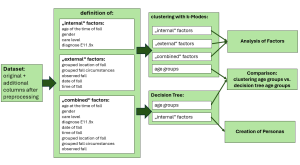Analyzing Fall Patterns for “Smart Companion” Behavior Adaption: Insights through an Exploratory Study Based on Extensive Austrian Elderly Care Data
Aim and Research Question(s)
Falls pose a significant threat to the health and autonomy of elderly people that can negatively impact their quality of life. As the global population ages, the incidence of falls among the elderly is a concern for families and healthcare providers alike. (Hefny, Abbas, and Abu-Zidan 2016) (Radecki et al. 2020) Q1: Which demographic and clinical characteristics may predict the suitability of the “Smart Companion” for fall detection and assistance, regarding considerations such as age, gender, care levels, and diabetes diagnosis? Q2: How are environmental factors - such as time of day, location, daily temperature, daylight savings time periods, and natural light sources - observed to correlate with incidents of falls, and how frequently do these factors appear in the data?
Background
The “Smart Companion” is an assistive technology currently under development and assessment at FH St. Pölten. At its core, the “Smart Companion” combines a vacuum robot with smart speaker technology, such as Amazon’s “Alexa” and custom sensors, to create a multifunctional assistance system. The “Smart Companion” can detect fallen individuals and provide timely assistance. (Jakl Andreas et al., 2021) The "Akademie für Altersforschung" (AAF) in Vienna has provided an extensive dataset that includes a total of 14,579 individually recorded fall incidents in elderly care hospitals in Vienna.
Methods
The k-Modes algorithm grouped falls based on "internal", "external", and "combined factors". Clusters revealed distinct fall risk profiles by identifying centroids that represent similar fall incidents.
A decision tree model identified key predictors of fall risk, such as age, gender, care level, and diabetes. The model highlighted high-risk subgroups, especially those with higher care needs. Risk profiles as "Personas" were developed based on the decision tree results to support personalized fall prevention strategies.

Results and Discussion
The k-Modes clustering revealed patterns in fall risk based on demographic and environmental factors. High-risk groups included older individuals (70+ years), individuals with higher care levels, and falls occurring in living areas during the evening. The decision tree identified age, care level, and diabetes diagnosis as key predictors of fall risk. Individuals aged 85-90 with high care needs showed a significantly higher likelihood of multiple falls.
Conclusion
This thesis identified key demographic and environmental factors influencing fall risk in elderly individuals, including age, care level, and the time and location of falls. The findings provide actionable insights for improving assistive technologies like the "Smart Companion" by suggesting "personalized risk assessments" and real-time environmental monitoring.
References
Hefny et al., 2016. ‘Geriatric Fall-Related Injuries’. African Health Sciences 16(2):554. doi: 10.4314/ahs.v16i2.24. Radecki et al., 2020. ‘Innovating Fall Safety: Engaging Patients as Experts’. Journal of Nursing Care Quality 35(3):220–26. doi: 10.1097/NCQ.0000000000000447. Jakl Andreas et al., 2021. ‘Smart Companion Active AI Assistant To Support Autonomous Living’.
